Mixed-Criticality Traffic Scheduling in Time-Sensitive Networking Using Multiple Combinatorial Packing Based on Free Time Domain
Abstract
1. Introduction
1.1. Background
1.2. Related Works
1.3. Contributions
2. System Model
2.1. Network Architecture Model
2.2. TSN Switch Architecture
2.3. Mixed-Criticality Traffic Model
3. Mixed-Critical Traffic Scheduling Problem Based on Combinatorial Packing
3.1. Transformation of Flow Scheduling Problem
3.2. Scheduling Constraints
- (1).
- Collision-free transmission constraints for TT flows.
- (2).
- Path sequence constraints for flows.
- (3).
- End-to-end latency constraints.
- (4).
- Simultaneous forwarding constraints for multicast flows.
- (5).
- Network bandwidth constraints.
4. TSN Mixed-Criticality Traffic Scheduling Algorithm
4.1. Flows (Items) Preprocessing Phase
4.2. Combinatorial Packing Traffic Scheduling Algorithm Based on Unoccupied Space (CPTSA-US)
| Algorithm 1 Combinatorial Packing Traffic Scheduling Algorithm Based on Unoccupied Space (CPTSA-US) |
|
4.3. Mixed-Critical Traffic Scheduling Algorithm Based on Free Time Domain (MCTSA-FTD)
| Algorithm 2 Mixed-Critical Traffic Scheduling Algorithm Based on Free Time Domain (MCTSA-FTD) |
|
4.4. Schedule Table Calculation and Generation
5. Analysis of Simulation Results
5.1. Experiment Setup
5.2. Experiment Result
5.3. Delay and Stability Analysis
5.4. Packet Loss Rate Analysis
6. Conclusions
7. Future Work
Author Contributions
Funding
Data Availability Statement
Conflicts of Interest
References
- Li, Z.H.; Yang, S.Q.; Yu, J.H.; Deng, Y.D.; Wan, H. State-of-the-Art Survey of Deterministic Transmission Technologies in Time-Sensitive Networking. Ruan Jian Xue Bao/J. Softw. 2021, 33, 4334–4355. (In Chinese) [Google Scholar]
- Lokman, S.F.; Othman, A.T.; Abu-Bakar, M.H. Intrusion detection system for automotive Controller Area Network (CAN) bus system: A review. EURASIP J. Wirel. Commun. Netw. 2019, 2019, 184. [Google Scholar] [CrossRef]
- Zhao, L.; He, F.; Li, E.; Lu, J. Comparison of time sensitive networking (TSN) and TTEthernet. In Proceedings of the 2018 IEEE/AIAA 37th Digital Avionics Systems Conference (DASC), London, UK, 23–27 September 2018; pp. 1–7. [Google Scholar]
- Finzi, A.; Mifdaoui, A.; Frances, F.; Lochin, E. Network calculus-based timing analysis of AFDX networks with strict priority and TSN/BLS shapers. In Proceedings of the2018 IEEE 13th International Symposium on Industrial Embedded Systems (SIES), Graz, Austria, 6–8 June 2018; pp. 1–10. [Google Scholar]
- Nsaibi, S.; Leurs, L.; Schotten, H.D. Formal and simulation-based timing analysis of Industrial-Ethernet sercos III over TSN. In Proceedings of the 2017 IEEE/ACM 21st International Symposium on Distributed Simulation and Real Time Applications (DS-RT), Rome, Italy, 18–20 October 2017; pp. 1–8. [Google Scholar]
- Nguyen, V.Q.; Jeon, J.W. EtherCAT network latency analysis. In Proceedings of the 2016 International Conference on Computing, Communication and Automation (ICCCA), Greater Noida, India, 29–30 April 2016; pp. 432–436. [Google Scholar]
- Dias, A.L.; Sestito, G.S.; Turcato, A.C.; Brandão, D. Panorama, challenges and opportunities in PROFINET protocol research. In Proceedings of the 2018 13th IEEE International Conference on Industry Applications (INDUSCON), Sao Paulo, Brazil, 12–14 November 2018; pp. 186–193. [Google Scholar]
- Val, I.; Seijo, O.; Torrego, R.; Astarloa, A. IEEE 802.1 AS clock synchronization performance evaluation of an integrated wired–wireless TSN architecture. IEEE Trans. Ind. Inform. 2021, 18, 2986–2999. [Google Scholar] [CrossRef]
- Reusch, N.; Zhao, L.; Craciunas, S.S.; Pop, P. Window-based schedule synthesis for industrial IEEE 802.1 Qbv TSN networks. In Proceedings of the 2020 16th IEEE International Conference on Factory Communication Systems (WFCS), Porto, Portugal, 27–29 April 2020; pp. 1–4. [Google Scholar]
- Stüber, T.; Osswald, L.; Lindner, S.; Menth, M. A survey of scheduling algorithms for the time-aware shaper in time-sensitive networking (TSN). IEEE Access 2023, 11, 61192–61233. [Google Scholar] [CrossRef]
- Candell, R.; Montgomery, K.; Hany, M.K.; Sudhakaran, S.; Cavalcanti, D. Scheduling for Time-Critical Applications Utilizing TCP in Software-Based 802.1 Qbv Wireless TSN. In Proceedings of the 2023 IEEE 19th International Conference on Factory Communication Systems (WFCS), Pavia, Italy, 26–28 April 2023; pp. 1–8. [Google Scholar]
- Maile, L.; Voitlein, D.; Hielscher, K.S.; German, R. Ensuring reliable and predictable behavior of IEEE 802.1 CB frame replication and elimination. In Proceedings of the ICC 2022-IEEE International Conference on Communications, Seoul, Republic of Korea, 16–20 May 2022; pp. 2706–2712. [Google Scholar]
- Nasrallah, A.; Balasubramanian, V.; Thyagaturu, A.; Reisslein, M.; ElBakoury, H. Reconfiguration algorithms for high precision communications in time sensitive networks: Time-aware shaper configuration with IEEE 802.1 qcc (extended version). arXiv 2019, arXiv:1906.11596. [Google Scholar]
- Patti, G.; Bello, L.L. Performance assessment of the IEEE 802.1 Q in automotive applications. In Proceedings of the 2019 AEIT International Conference of Electrical and Electronic Technologies for Automotive (AEIT AUTOMOTIVE), Turin, Italy, 2–4 July 2019; pp. 1–6. [Google Scholar]
- Barzegaran, M.; Pop, P. Communication scheduling for control performance in TSN-based fog computing platforms. IEEE Access 2021, 9, 50782–50797. [Google Scholar] [CrossRef]
- Atallah, A.A.; Hamad, G.B.; Mohamed, O.A. Routing and scheduling of time-triggered traffic in time-sensitive networks. IEEE Trans. Ind. Inform. 2019, 16, 4525–4534. [Google Scholar] [CrossRef]
- Yan, W.; Wei, D.; Fu, B.; Li, R.; Xie, G. A Mixed-Criticality Traffic Scheduler with Mitigating Congestion for CAN-to-TSN Gateway. ACM Trans. Des. Autom. Electron. Syst. 2024. [Google Scholar] [CrossRef]
- Chahed, H.; Kassler, A. TSN Network Scheduling-Challenges and Approaches. Network 2023, 3, 585–624. [Google Scholar] [CrossRef]
- Nie, H.; Li, S.; Liu, Y. An Enhanced Routing and Scheduling Mechanism for Time-Triggered Traffic with Large Period Differences in Time-Sensitive Networking. Appl. Sci. 2022, 12, 4448. [Google Scholar] [CrossRef]
- Raagaard, M.L.; Pop, P. Optimization Algorithms for the Scheduling of IEEE 802.1 Time-Sensitive Networking (TSN); Technical Report; Technical University of Denmark: Lyngby, Denmark, 2017. [Google Scholar]
- Pahlevan, M.; Obermaisser, R. Genetic algorithm for scheduling time-triggered traffic in time-sensitive networks. In Proceedings of the 2018 IEEE 23rd International Conference on Emerging Technologies and Factory Automation (ETFA), Torino, Italy, 4–7 September 2018; Volume 1, pp. 337–344. [Google Scholar]
- Chuang, C.C.; Yu, T.H.; Lin, C.W.; Pang, A.C.; Hsieh, T.J. Online stream-aware routing for TSN-based industrial control systems. In Proceedings of the 2020 25th IEEE International Conference on Emerging Technologies and Factory Automation (ETFA), Vienna, Austria, 8–11 September 2020; Volume 1, pp. 254–261. [Google Scholar]
- Tamas-Selicean, D.; Pop, P.; Steiner, W. Design optimization of TTEthernet-based distributed real-time systems. Real-Time Syst. 2015, 51, 1–35. [Google Scholar] [CrossRef]
- Gavrilut, V.; Pop, P. Traffic-type assignment for TSN-based mixed-criticality cyber-physical systems. ACM Trans. -Cyber-Phys. Syst. 2020, 4, 1–27. [Google Scholar] [CrossRef]
- Gavrilut, V.; Pop, P. Scheduling in time sensitive networks (TSN) for mixed-criticality industrial applications. In Proceedings of the 2018 14th IEEE International Workshop on Factory Communication Systems (WFCS), Imperia, Italy, 13–15 June 2018; pp. 1–4. [Google Scholar]
- De Moura, L.; Bjorner, N. Satisfiability modulo theories: Introduction and applications. Commun. ACM 2011, 54, 69–77. [Google Scholar] [CrossRef]
- Oliver, R.S.; Craciunas, S.S.; Steiner, W. IEEE 802.1 Qbv gate control list synthesis using array theory encoding. In Proceedings of the 2018 IEEE Real-Time and Embedded Technology and Applications Symposium (RTAS), Porto, Portugal, 11–13 April 2018; pp. 13–24. [Google Scholar]
- Jin, X.; Xia, C.; Guan, N.; Xu, C.; Li, D.; Yin, Y.; Zeng, P. Real-time scheduling of massive data in time sensitive networks with a limited number of schedule entries. IEEE Access 2020, 8, 6751–6767. [Google Scholar] [CrossRef]
- Li, Q.; Li, D.; Jin, X.; Wang, Q.; Zeng, P. A simple and efficient time-sensitive networking traffic scheduling method for industrial scenarios. Electronics 2020, 9, 2131. [Google Scholar] [CrossRef]
- Zhang, M. Research on Approximation Algorithms for Online Bin Packing and Hybrid Flowshop Scheduling Problems. Ph.D. Thesis, Dalian University of Technology, Dalian, China, 2019; pp. 20–72. (In Chinese). [Google Scholar]
- Wang, H. Research on Performance Optimization and Evaluation Technology of Time Trigged Ethernet for DIMA Applications. Ph.D. Thesis, Xidian University, Xi’an, China, 2019; pp. 55–70. (In Chinese). [Google Scholar]
- Luan, B. Research on Time Triggered Service Scheduling Algorithm in Time Triggered Ethernet. Master’s Thesis, Xidian University, Xi’an, China, 2019; pp. 11–21. (In Chinese). [Google Scholar]
- Syed, A.A.; Ayaz, S.; Leinmvller, T.; Chandra, M. MIP-based joint scheduling and routing with load balancing for TSN based in-vehicle networks. In Proceedings of the 2020 IEEE Vehicular Networking Conference (VNC), New York, NY, USA, 16–18 December 2020; pp. 1–7. [Google Scholar]
- Xue, J.; Shou, G.; Liu, Y.; Hu, Y. Scheduling Time-Critical Traffic with Virtual Queues in Software-Defined Time-Sensitive Networking. IEEE Trans. Netw. Serv. Manag. 2023. [Google Scholar] [CrossRef]
- Deng, L.; Xiao, X.R.; Liu, H.; Li, R.; Xie, G. A low-delay AVB flow scheduling method occupying the guard band in Time-Sensitive Networking. J. Syst. Archit. 2022, 129, 102586. [Google Scholar] [CrossRef]
- Ojewale, M.A.; Yomsi, P.M.; Nikolic, B. Worst-case traversal time analysis of tsn with multi-level preemption. J. Syst. Archit. 2021, 116, 102079. [Google Scholar] [CrossRef]
- Zheng, X.; Liu, Y.; Zhan, S.; Xin, Y.; Wang, Y. A novel low-latency scheduling approach of TSN for multi-link rate networking. Comput. Netw. 2024, 240, 110184. [Google Scholar] [CrossRef]
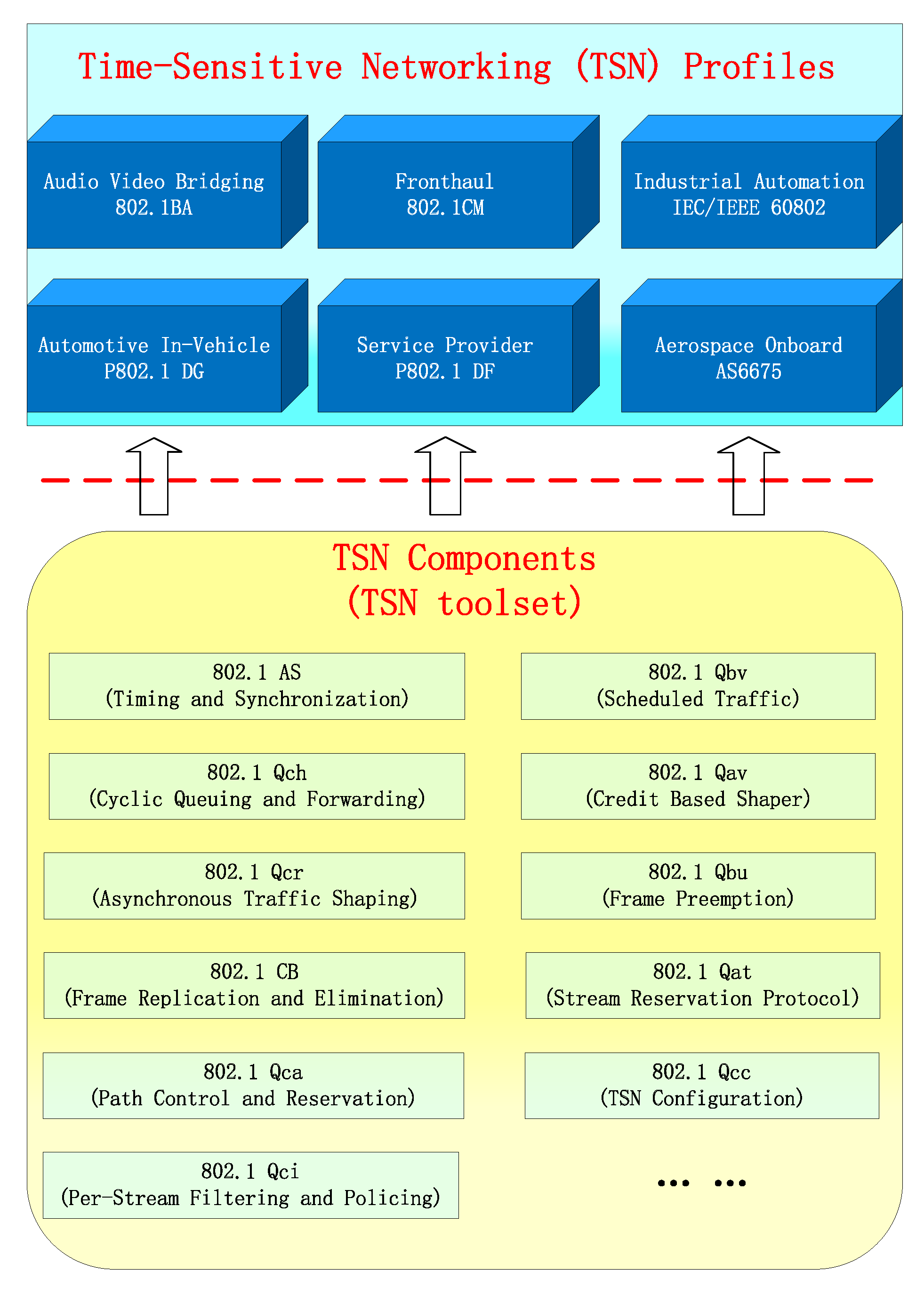
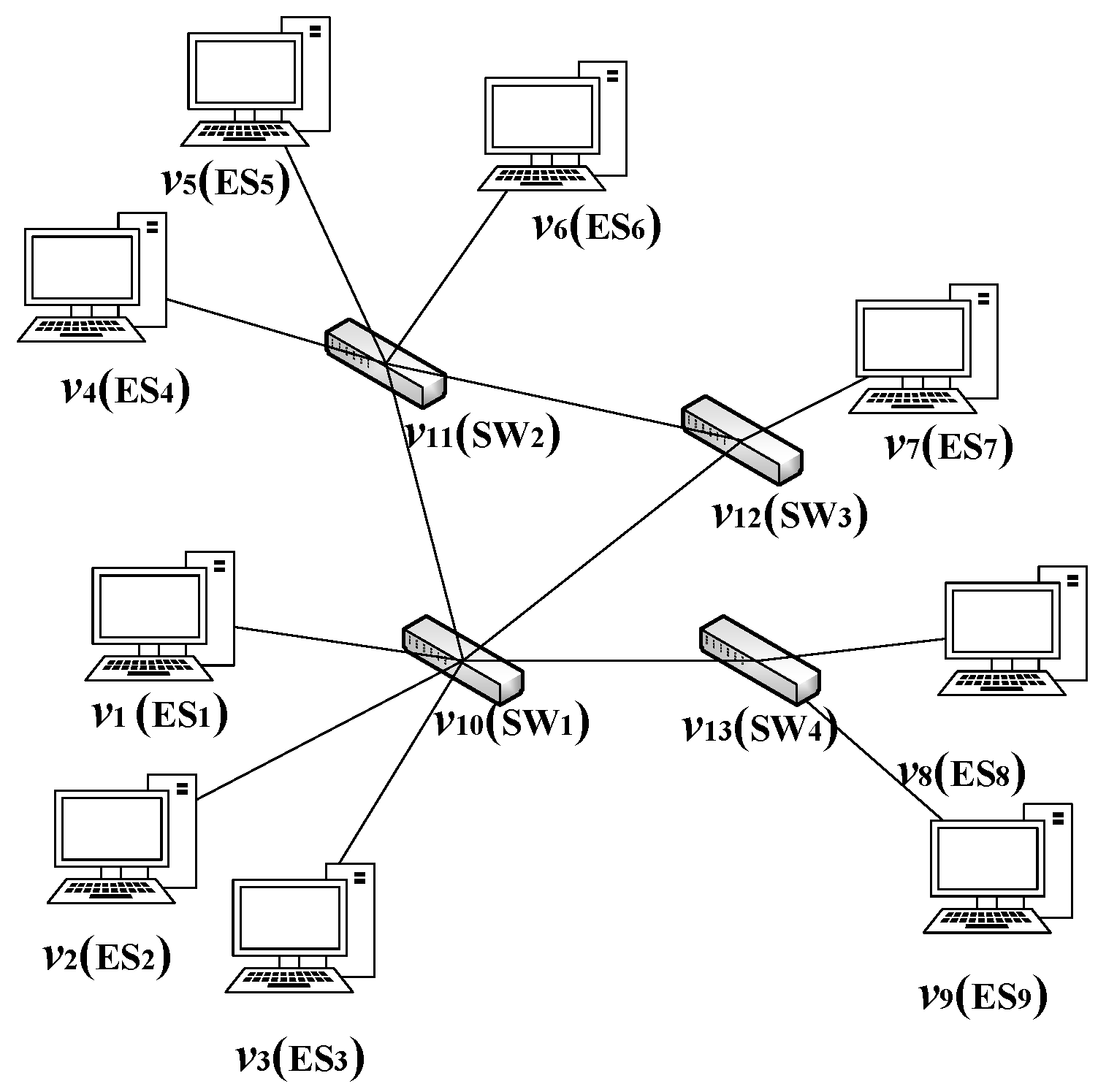

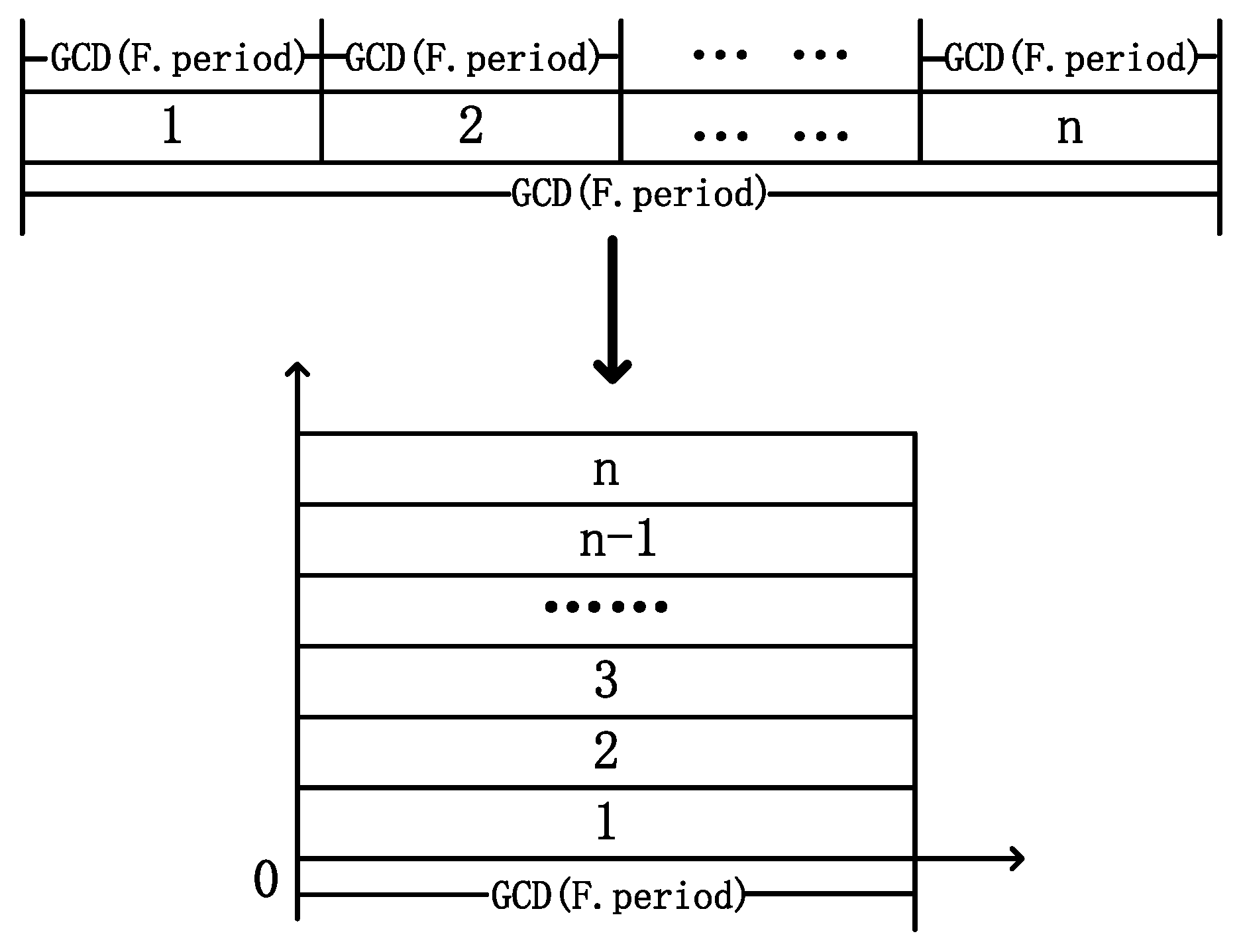

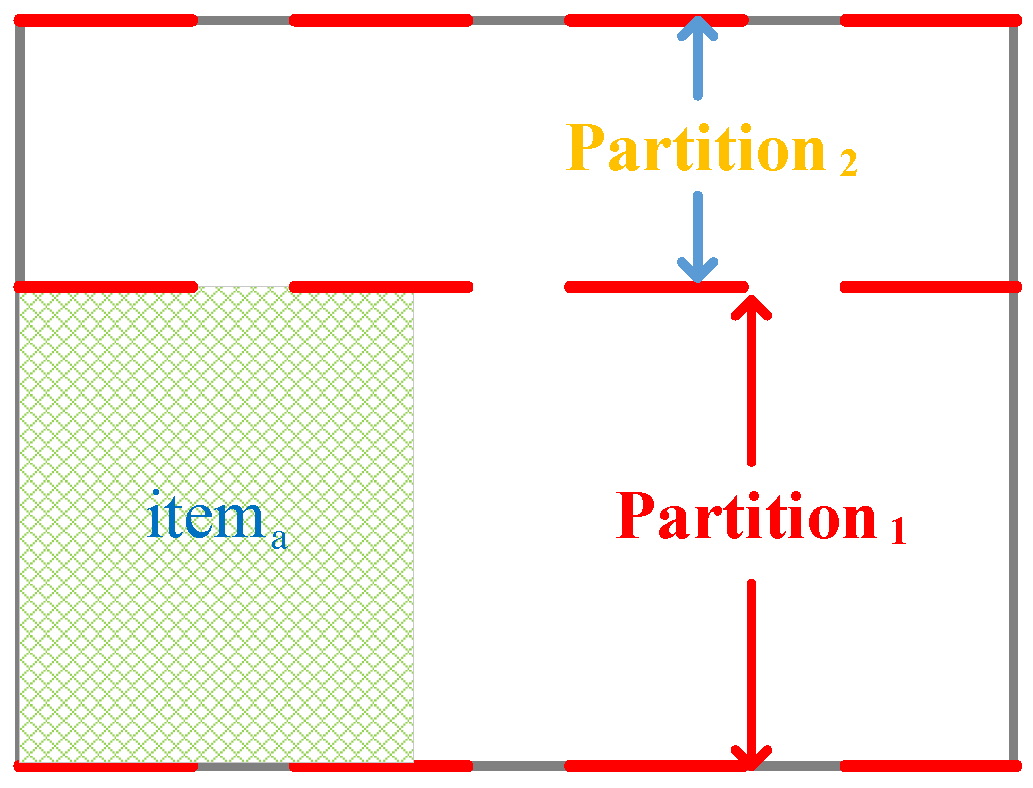
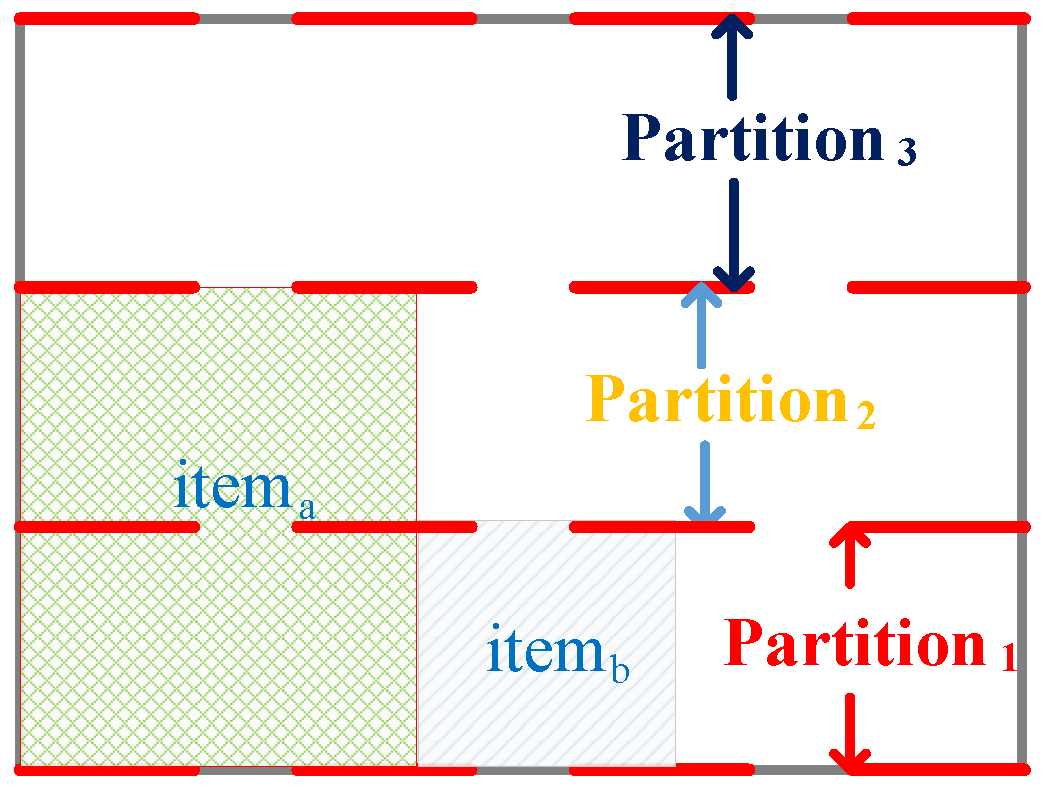
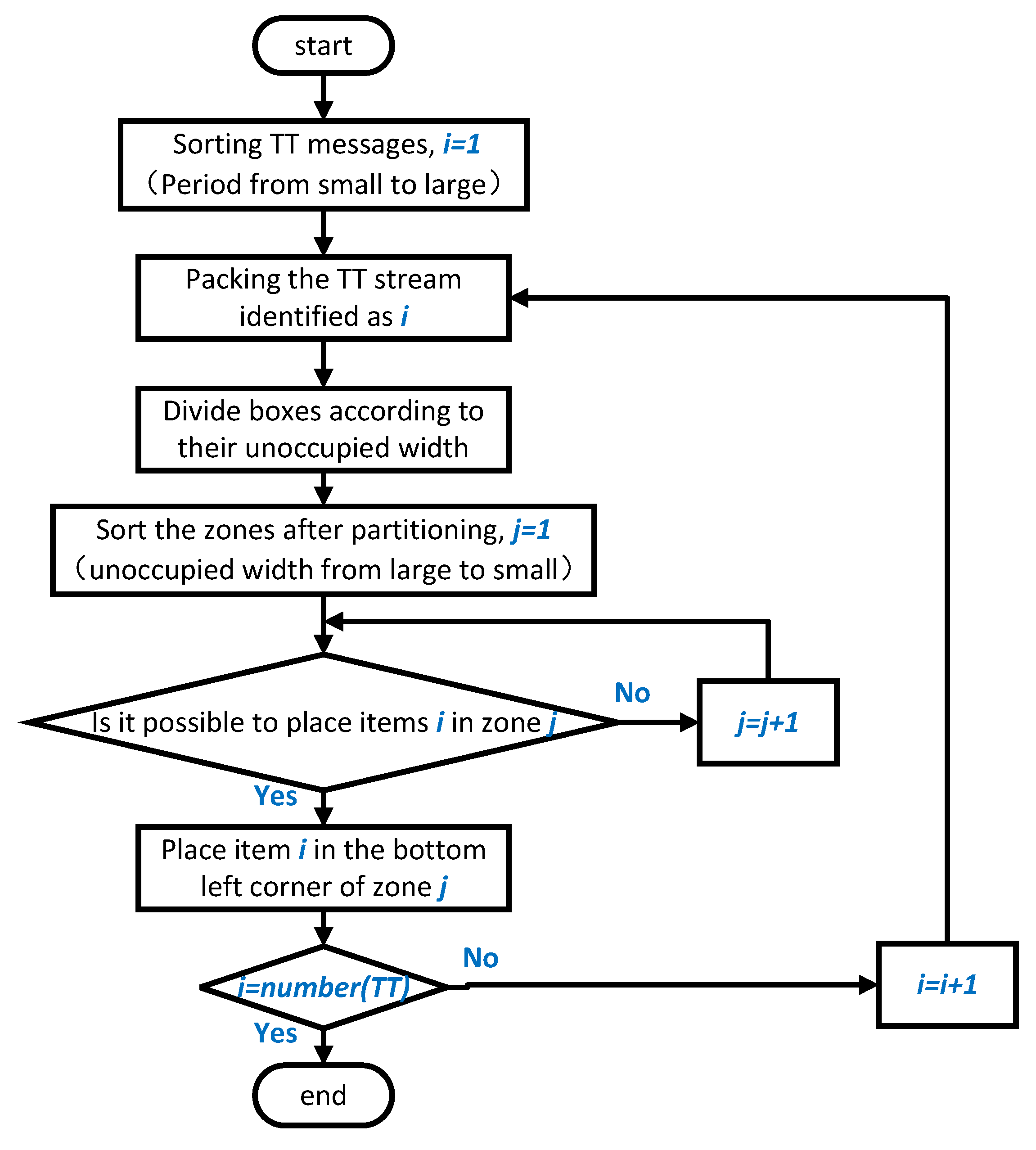
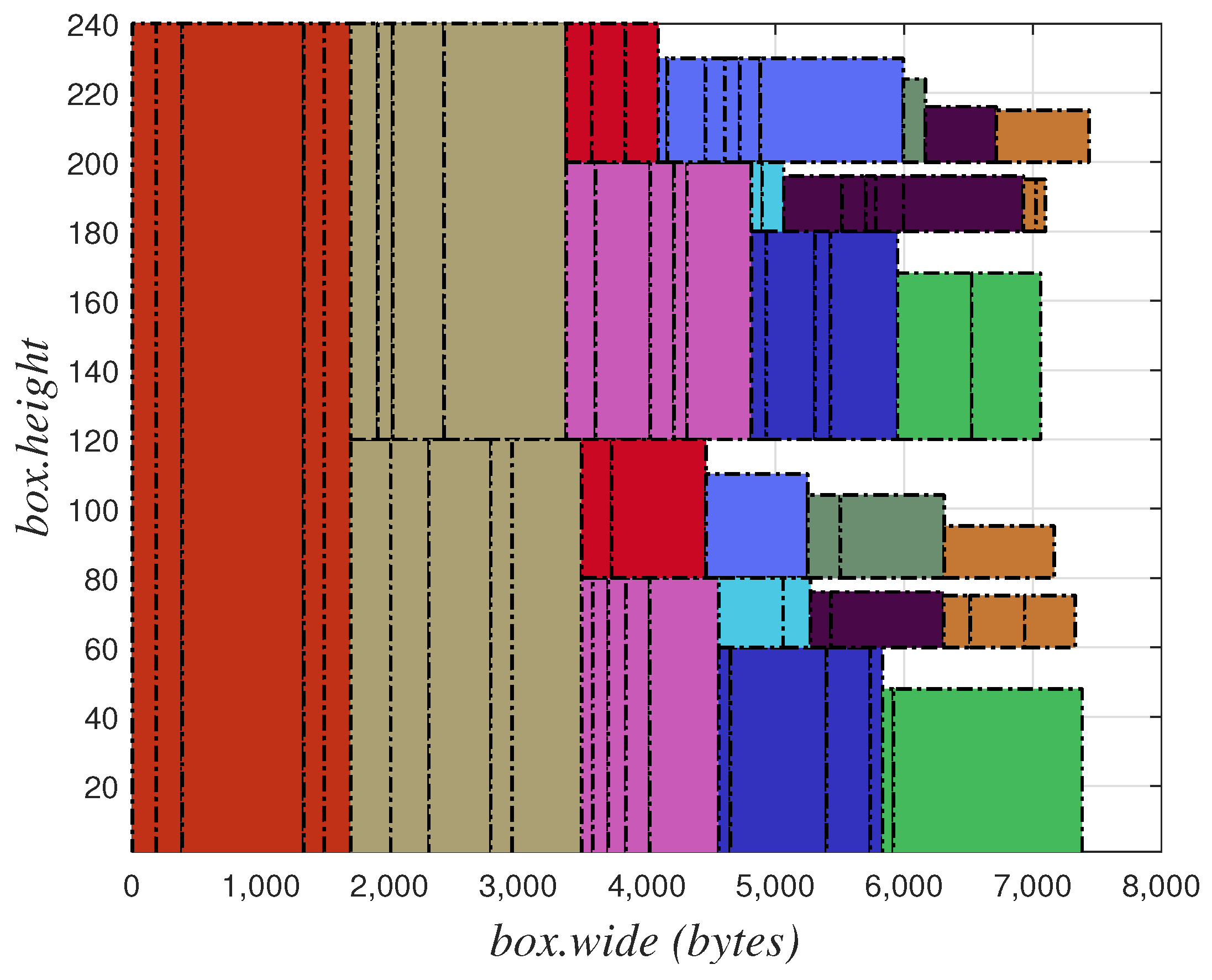
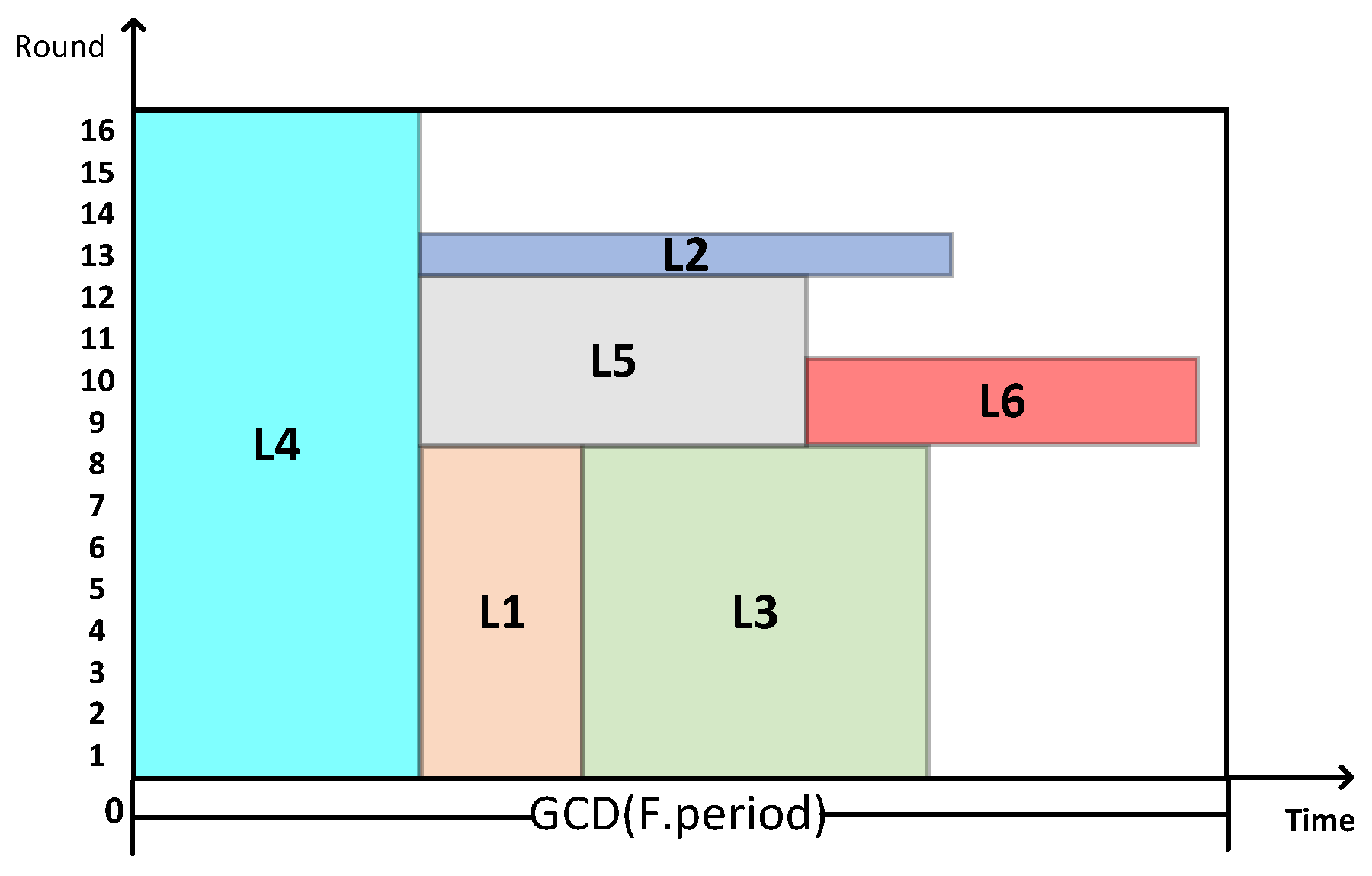
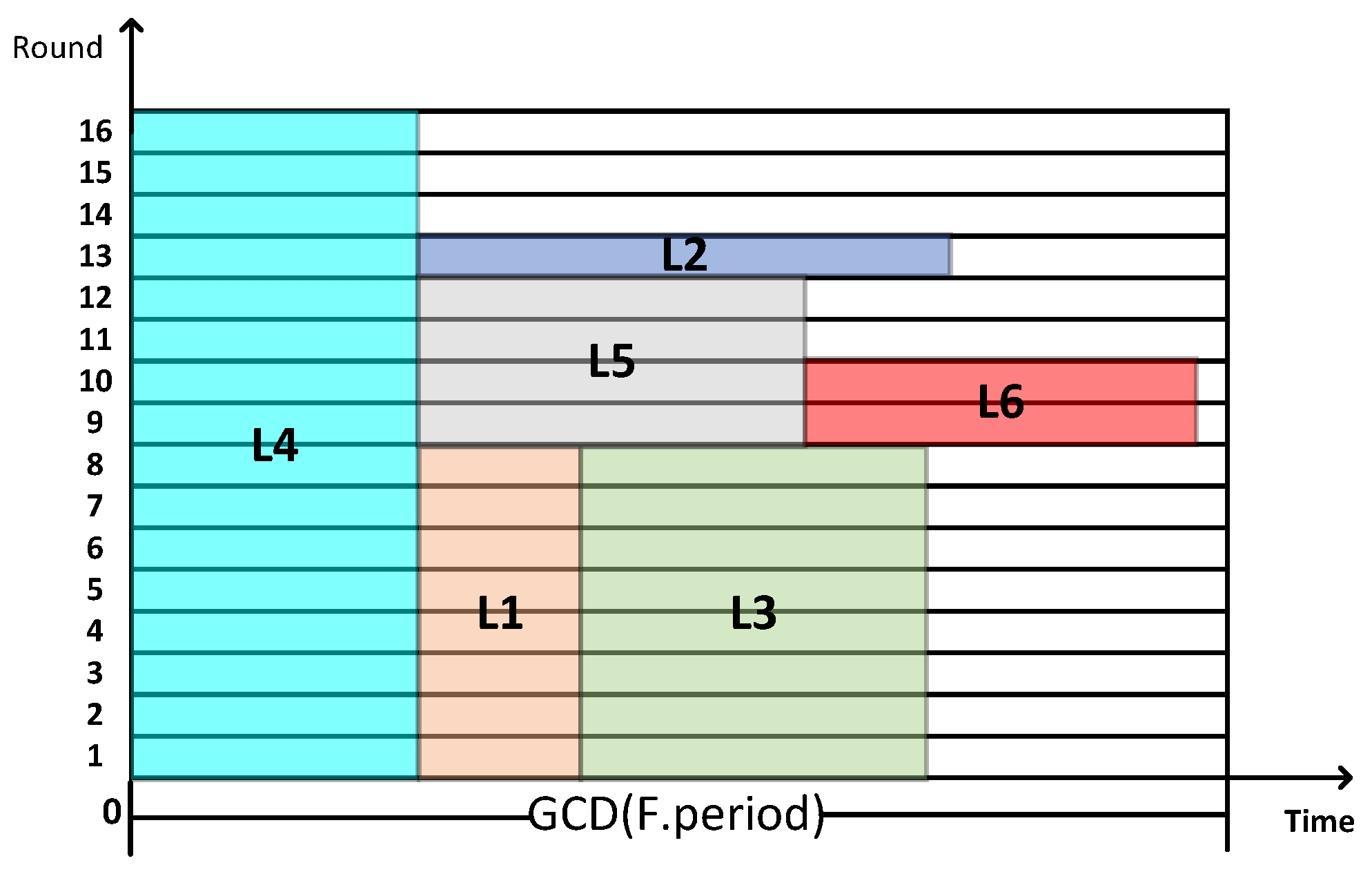




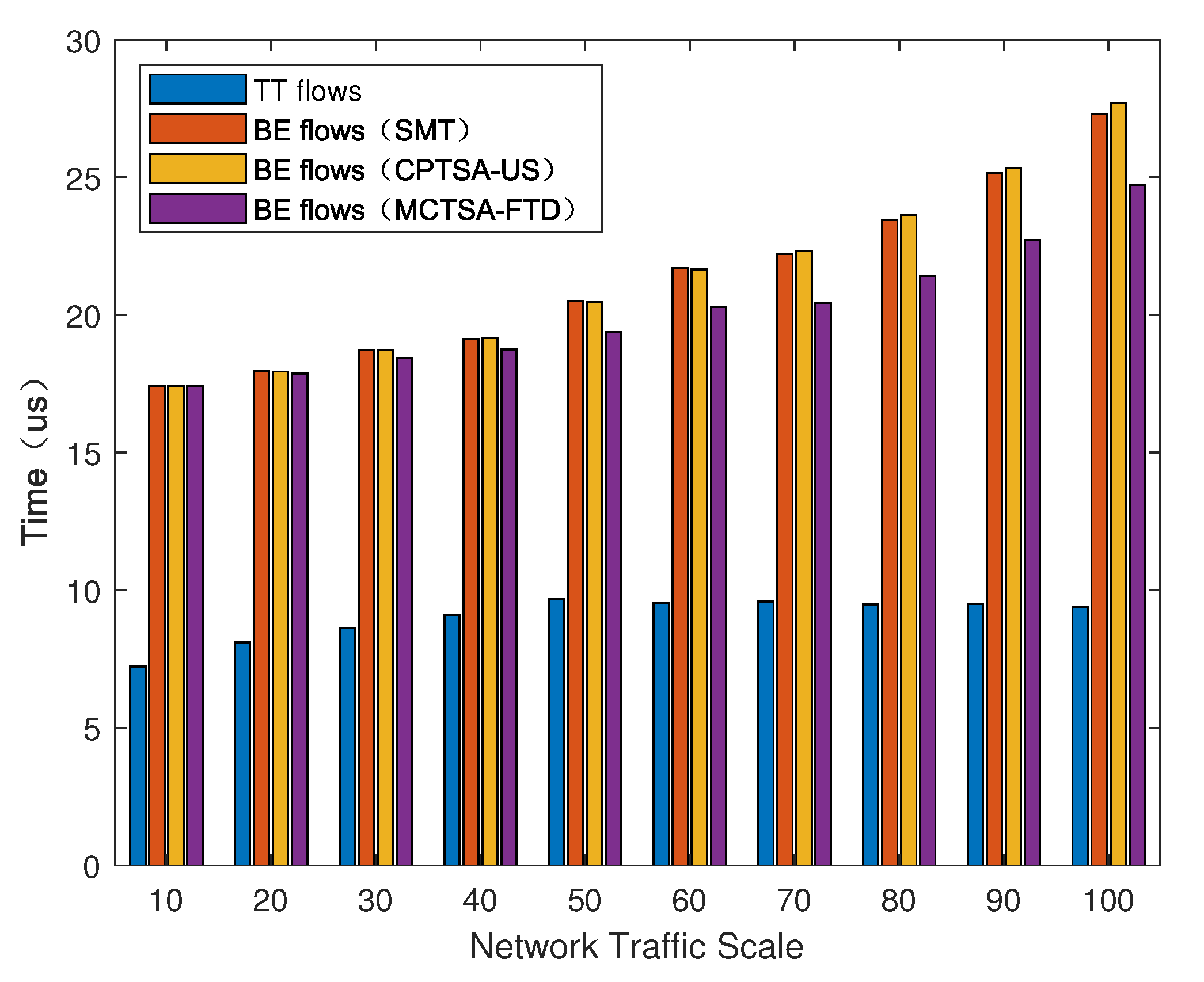
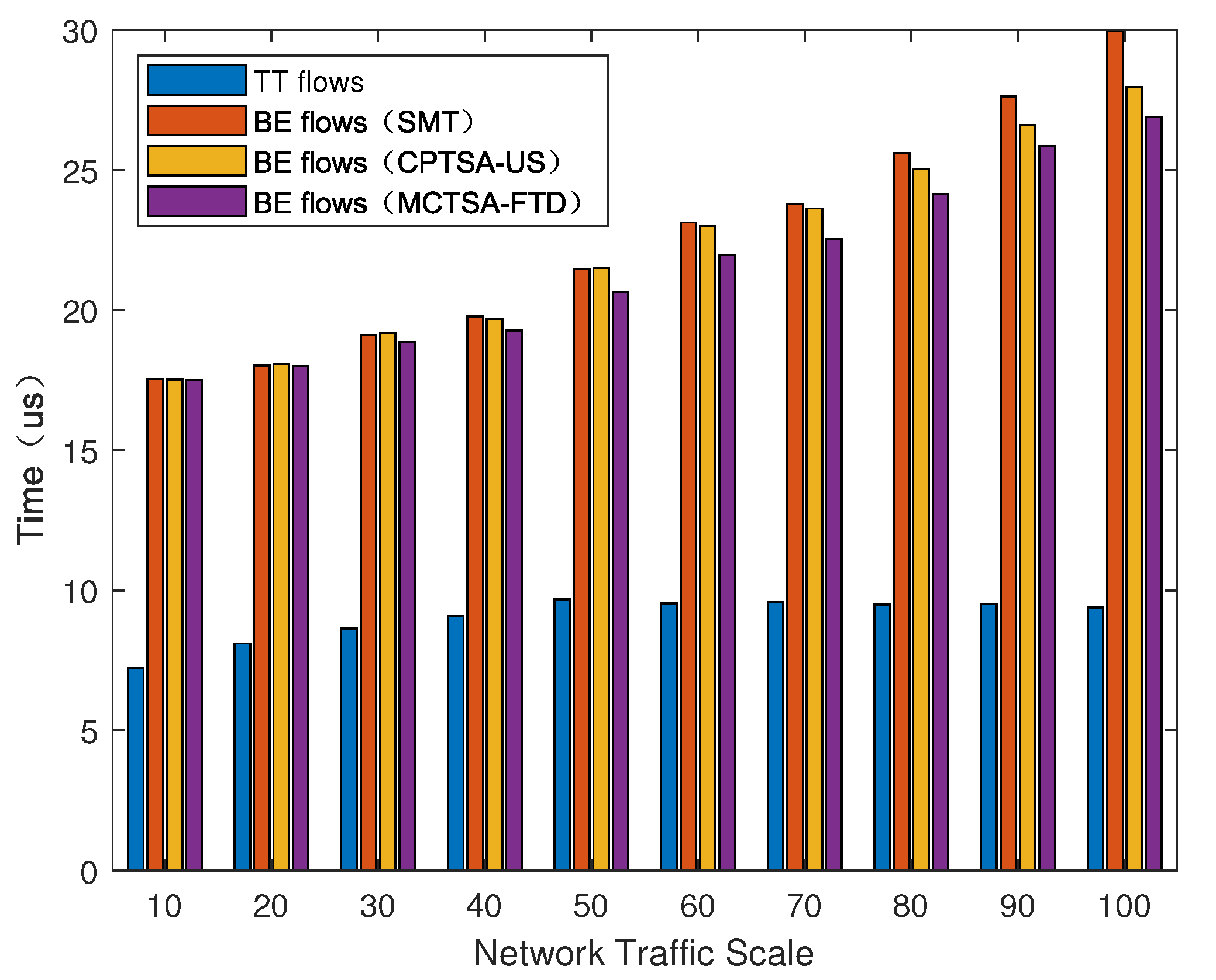


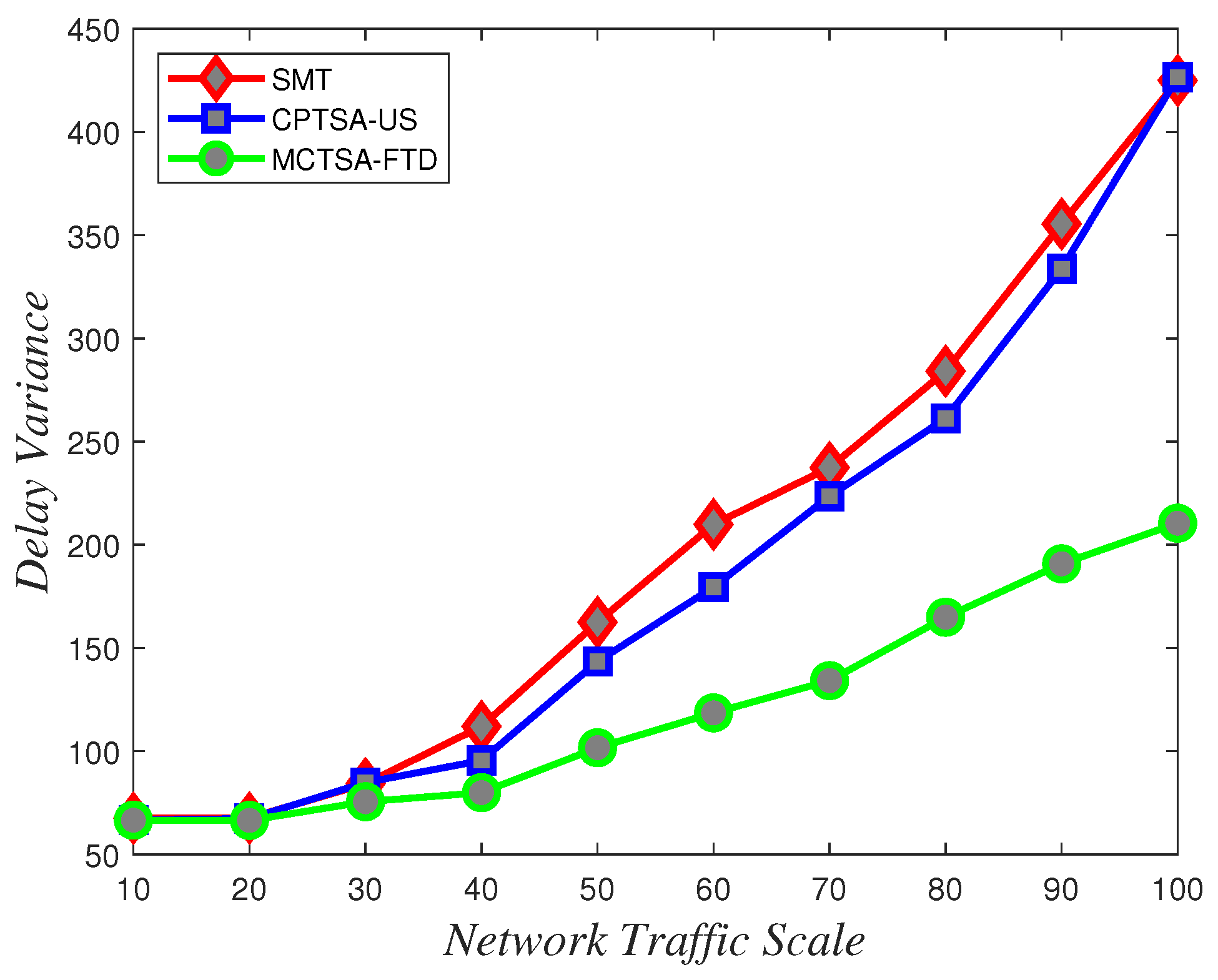



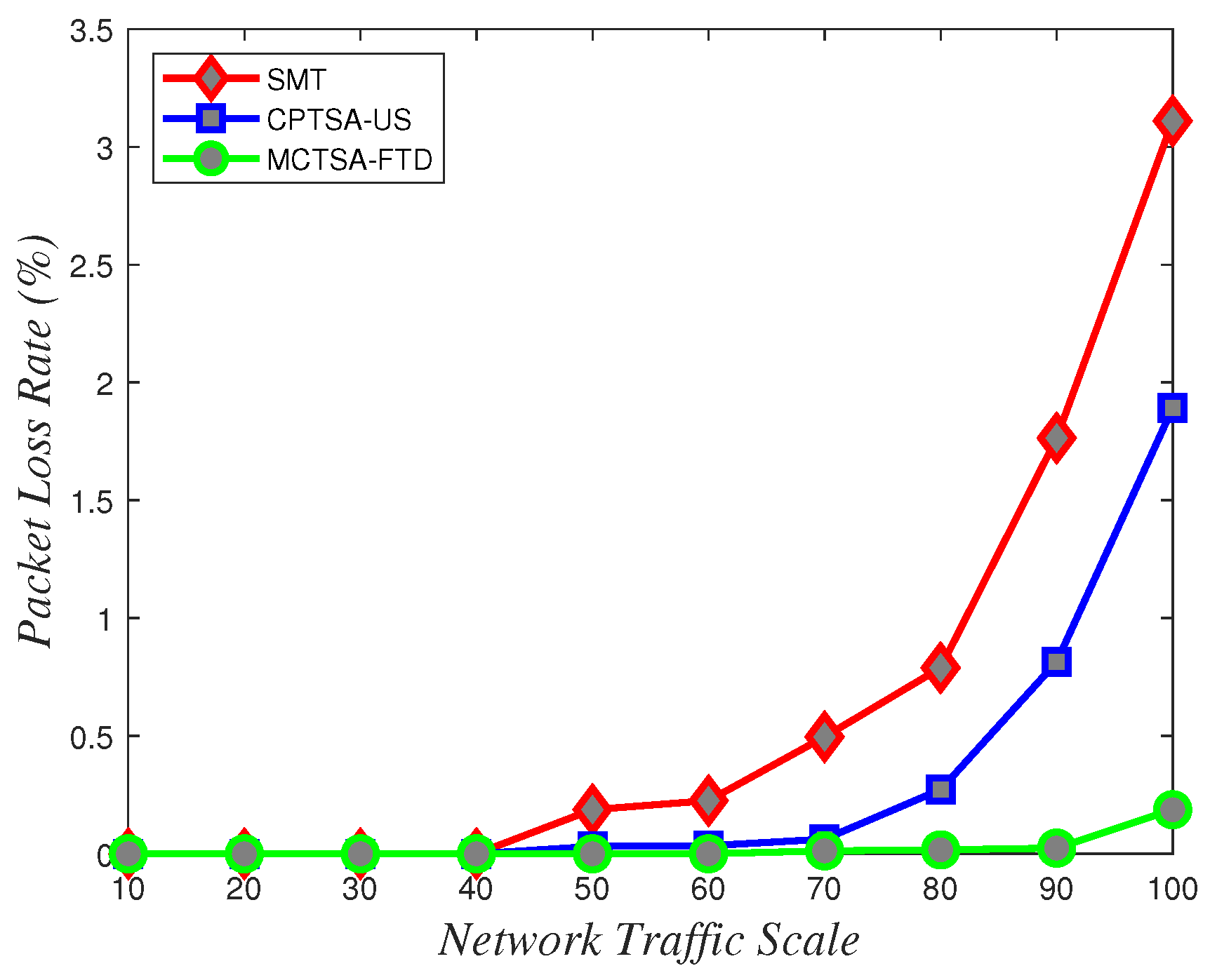


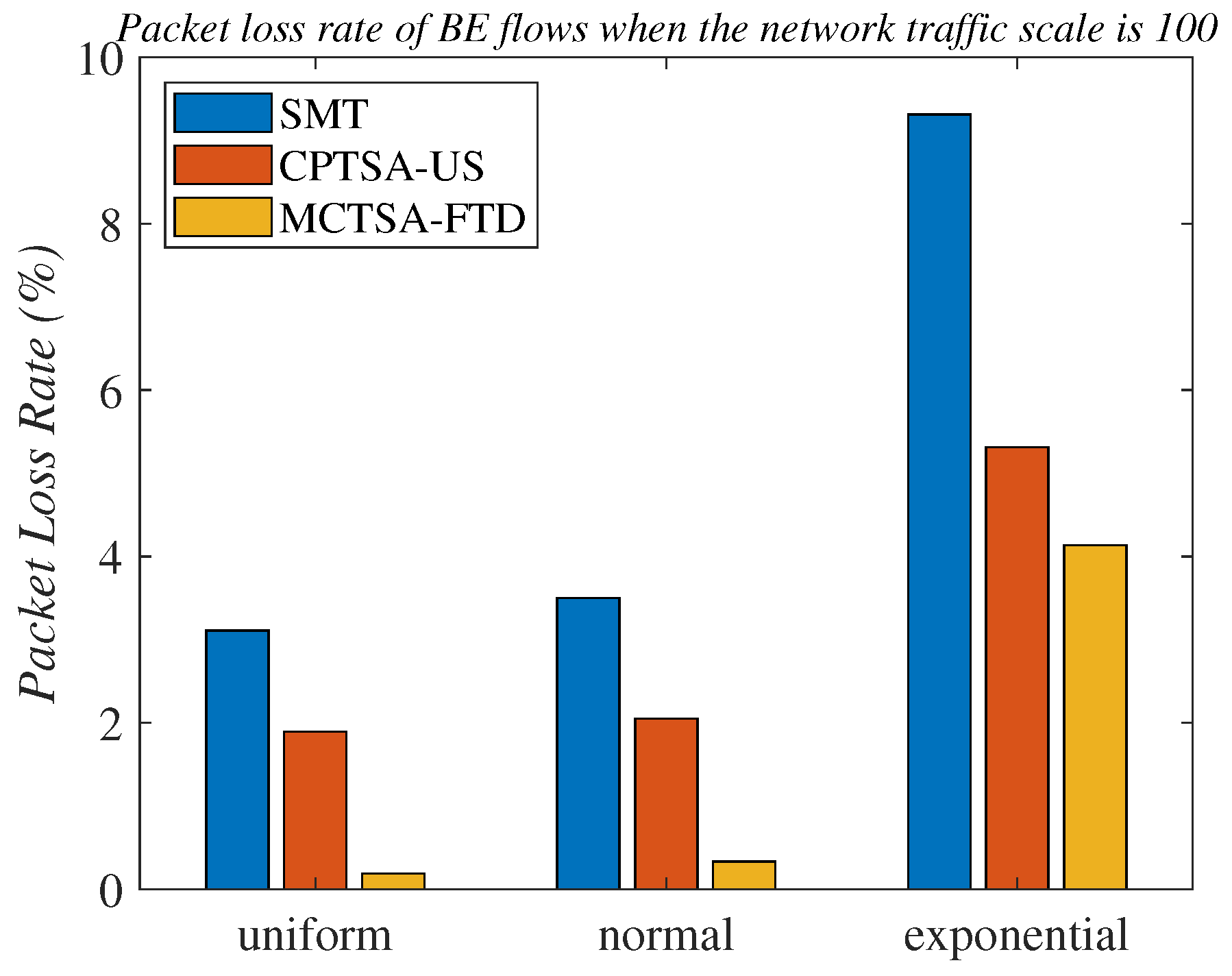
| SMT | CPTSA-US | MCTSA-FTD | |
|---|---|---|---|
| uniform distribution | 3.11 | 1.89 | 0.19 |
| normal distribution | 3.50 | 2.05 | 0.33 |
| exponential distribution | 9.31 | 5.31 | 4.13 |
Disclaimer/Publisher’s Note: The statements, opinions and data contained in all publications are solely those of the individual author(s) and contributor(s) and not of MDPI and/or the editor(s). MDPI and/or the editor(s) disclaim responsibility for any injury to people or property resulting from any ideas, methods, instructions or products referred to in the content. |
© 2024 by the authors. Licensee MDPI, Basel, Switzerland. This article is an open access article distributed under the terms and conditions of the Creative Commons Attribution (CC BY) license (https://creativecommons.org/licenses/by/4.0/).
Share and Cite
Zheng, L.; Zhang, K.; Wei, G.; Chu, H. Mixed-Criticality Traffic Scheduling in Time-Sensitive Networking Using Multiple Combinatorial Packing Based on Free Time Domain. Electronics 2024, 13, 2644. https://doi.org/10.3390/electronics13132644
Zheng L, Zhang K, Wei G, Chu H. Mixed-Criticality Traffic Scheduling in Time-Sensitive Networking Using Multiple Combinatorial Packing Based on Free Time Domain. Electronics. 2024; 13(13):2644. https://doi.org/10.3390/electronics13132644
Chicago/Turabian StyleZheng, Ling, Keyao Zhang, Guodong Wei, and Hongyun Chu. 2024. "Mixed-Criticality Traffic Scheduling in Time-Sensitive Networking Using Multiple Combinatorial Packing Based on Free Time Domain" Electronics 13, no. 13: 2644. https://doi.org/10.3390/electronics13132644
APA StyleZheng, L., Zhang, K., Wei, G., & Chu, H. (2024). Mixed-Criticality Traffic Scheduling in Time-Sensitive Networking Using Multiple Combinatorial Packing Based on Free Time Domain. Electronics, 13(13), 2644. https://doi.org/10.3390/electronics13132644






